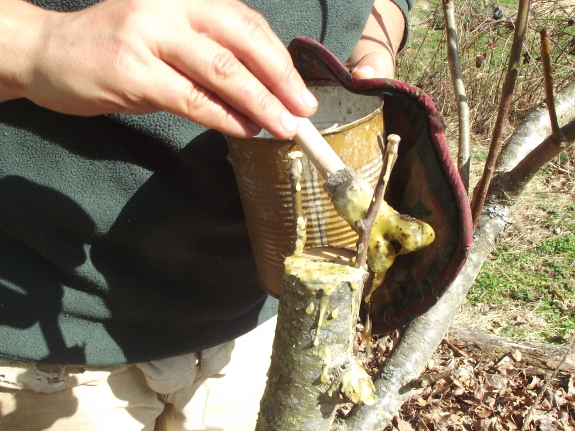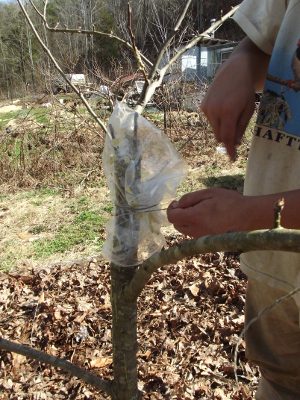
Homemade graft sealing

The final step in any
grafting project is to seal all cut surfaces so they don't dry out
before they're able to heal. Professionals buy grafting tar or
parafilm, but I wanted to try some materials I already had on hand.
The trick with using
beeswax or some other homegrown compound to seal your grafting cuts is
that hot wax can damage the cambium of the tree. I opted to dab
on mostly melted beeswax, figuring it wouldn't hurt the tree as long as
it didn't burn my finger when I dripped a bit of melted wax on my
skin. This is the most experimental part of my project, though,
since no one else seems to use straight beeswax to seal their wounds.
 One recipe for making your
own sealing wax includes 1 part raw linseed oil, 2 parts beeswax, and 4
parts powdered rosin. Someone else kneaded mineral oil into hobby
clay to make a sealing compound. I suspect both of these
compounds would be flexible enough that you could paint them on cold,
which would delete the potential heat problem.
One recipe for making your
own sealing wax includes 1 part raw linseed oil, 2 parts beeswax, and 4
parts powdered rosin. Someone else kneaded mineral oil into hobby
clay to make a sealing compound. I suspect both of these
compounds would be flexible enough that you could paint them on cold,
which would delete the potential heat problem.
No matter which compound
you use, you want to cover the tips of each piece of scionwood, then
liberally dab wax or tar on the top and sides of the cleft tree
trunk. Do your best to be more careful than I was and not cover
up any of the precious buds on the scionwood --- I had to pick a bit of
wax off with my fingernails.
Some sources suggest
tying a plastic bag over the top of the grafted area when you're done
for an added layer of protection. It sounds like you can use
carpenter's glue to seal the graft as long as you top it off with
aluminum foil and then a plastic bag. However, plastic bags
require more work since you'll need to keep them out of direct sunlight
so they don't heat up, and then you have to take the bag off once the
scionwood starts to grow. I'm thinking of deleting the plastic
bags, actually --- what do you think?
Despite taking five long
posts to tell you about this, I performed a cleft graft on two pear
trees in less than an hour, counting all of my practice cutting
time. So don't be scared away from the process. I'll report
back this summer as our scionwood (hopefully) starts to grow.
| This post is part of our Grafting Experiment lunchtime series.
Read all of the entries: |
Want more in-depth information? Browse through our books.
Or explore more posts by date or by subject.
About us: Anna Hess and Mark Hamilton spent over a decade living self-sufficiently in the mountains of Virginia before moving north to start over from scratch in the foothills of Ohio. They've experimented with permaculture, no-till gardening, trailersteading, home-based microbusinesses and much more, writing about their adventures in both blogs and books.
Want to be notified when new comments are posted on this page? Click on the RSS button after you add a comment to subscribe to the comment feed, or simply check the box beside "email replies to me" while writing your comment.

Normal carpenters glue (PVAc) dissolves in water. But cross-linking PVAc ("waterproof" carpenters glue) doesn't.
Moisture-curing (one-component) polyurethane lacquer doesn't produce heat and would seal very well, I think.
@Roland White PVA is not really carpenter's glue, although it can be used for light applications on wood. I think of it as craft glue.
Cross PVA is yellow and somewhat waterproof, commonly referred to as wood glue or carpenter's glue. It is an organic resin, so if applied thickly would provide a decent healthy sealant. I have to assume this is what Anna mentioned.
While polyurethane would create a perfect seal, the endgrain would soak it right up, requiring several coats. Also it is highly toxic and couldn't be good for a living tree. It would probably be drawn right up into the scionwood and might even kill the buds.
Wax seems superior to any of these options though and is generally very healthy to use on any kind of wood.
@Anna Is that a chicken bone!?
Jeremiah --- I'm glad you chimed in. I vaguely thought carpenter's glue was waterproof, but figured Roland knew better than I did. He's working against a language barrier, though, so it's easy for him to miss colloquialisms like that.
I was wondering a bit about whether any of those compounds would be toxic to the treat. Sounds like a vote against polyurethane.
No chicken bones --- that's the scionwood with a dab of wax at the top to seal the cut edge. (Or at least I think that's what you're looking at?)
Anna, I am asking what you are using to spread the wax. Somehow it looks like a leg bone, from a big chicken or a large deer? Maybe I am just very hungry.
I did more research on the PVAc vs yellow glue issue. It seems that both are called wood glue and carpenter's glue. Cross-linking PVAc is not yellow, still white, basically a waterproof version of Elmer's school glue. It is produced by the presence of Boron or Boric Acid but that doesn't necessarily mean it's toxic. After all, good old non-toxic Elmer's is a synthetic acetate and lord knows I've eaten a lion's share of that...
What carpenters call carpenter's glue is typically yellow wood glue and it is an organic resin. No relation to PVAc. If the boron component of the cross-linking PVAc is either stable or no longer present, it is definitely a good candidate for sealing.
Let me start by saying that the naming of polymers by the general public is very inprecise and often inaccurate. E.g. a hardened "epoxy glue" will contain few epoxide groups anymore. Most will have been consumed by the hardening reaction.
It is incorrect to label polyurethane polymers in general as highly toxic. Two component systems (that you have to mix, and that start curing after mixing) contain isocyanates as one of the components. Those isocyanates in general are an allergens and sensitizers. But their use is generally restricted to professionals, and often in closed mould applications. The two-component polyurethane lacquers generally available usually contain a prepolymer rather than pure isocyanate. One component polyurethane coatings generally use a different or hybrid chemistry. A reacted "polyurethane" polymer will hardly contain any loose polyols and isocyanates (probably down to 1--100 mg/kg level). They are rather inert macromolecules (in the IUPAC definition of the term).
I mentioned polyurethane lacquers because isocyanates (and prepolymers made from them) react very quickly with water forming urea linkages. The reaction with polyols (the other component of PU lacquers) is 100x slower. So it would seem unlikely that even a lacquer containing pure isocyanate would penetrate deeply into living wood.
But if you want a "natural" altarnative, look e.g. at the sap of toxicodendron vernicifluum (the chinese lacquer tree). When exposed to air and moisture it polymerizes to form a hard, clear and waterproof surface coating. The sap itself is an extreme irritant, though. A nice example of a natural substance not by definition being benign.
Generally, PVAC glue can be made into a crosslinked variety by adding a proper crosslinking agent. This can be e.g. a polyosicyanate (like Ponal D4), or boron trioxide (in combination with polyvinyl alcohol) as often used in "yellow glue". Not all cross-linked PVAC's glues are yellow.
I suspect that beeswax will be pretty much inert. I do wonder how long it will stay in place, especially when it gets warm (remember the tale of Icarus).
Jeremiah --- Nope, that's just a really awful foam brush that's seen much better days....
Jeremiah and Roland --- Thanks for the glue clarifications. I think of the yellow stuff as carpenter's glue too, but Jeremiah's my nephew, so it could be a family thing....
Roland --- I suspect you're right that longevity will be the tricky point with my beeswax. I need to remember to go check on it.... As long as it can keep the scionwood moist for a few weeks until it starts to grow, though, it'll be okay.
2coments in one. About 4 years ago one of my young pecan trees broke by the wind. It was a bad break and was connected by only about 1/3 of the wood and bark.I placed it back in the upright position with a strong splint and several zip ties. I coated the injury with an unused comode sealing ring which I had on hand. This material smeared easily over the damage without heating and stayed there until I removed it this spring.There are scars from the break but the healing was better than I could have hoped for......
This June I dug and potted 47 pecan seedlings. 39 are growing vigorously, the larger of which will be candidates for grafting in the spring.I really like your teaching style, and will be using much of your information. I will however be attempting the banana graft. I may be wrong by going this rout but it seems to have a good chance for success for a beginner
Don --- Fascinating to hear about your splicing experiences and grafting plans! My understanding is that nut trees are grafted with different methods than fruit trees most of the time, but I haven't researched them --- there's a good chance you're on the right track.
Unfortunately, it turned out that neither of my grafts took this spring, which could be due to the way topworking promotes fireblight. Or, as I later realized, it could be simply that the 17 year cicadas laid eggs in everything and made fireblight-like symptoms that knocked all of our fruit trees and blueberries back. But it's also possible my homemade grafting supplies weren't up to snuff, so be careful!